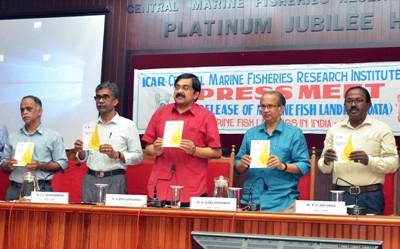KOCHI, 28 June 2018 : India’s marine fish production shows a sign of revival with the annual marine fish landings in 2017 registering 5.6% increase compared to the previous year. The data was released by the Kochi headquartered Central Marine Fisheries Research Institute (CMFRI) revealed.
The total marine fish landings in India (excluding Andaman & Nicobar and Lakshadweep islands) in 2017 was 3.83 million tonnes, with Gujarat remaining at the top position for the fifth consecutive year with contributing 7.86 lakh tonnes (20.5% of total landings) followed by Tamil Nadu and Kerala. This is the highest catch after a record-high landings in 2012.
Marine fish landings improved in all the maritime states other than Tamil Nadu and a palpable dip in the UTs of Puducherry and Daman & Diu. Revival of oil sardine in the western coastal states especially in Kerala played a major role in improving the country’s marine fish production this time.
However, the east coast witnessed a decline in the oil sardine catch with 83% drop in Andhra Pradesh and 36% in Tamil Nadu compared to 2016.
A total of 788 marine fish species were landed this time along the Indian coast with maximum numbers landed along the Tamil Nadu coast followed by Kerala and Maharashtra.
Oil sardine tops
Indian oil sardine, which was showing a decreasing trend for the past few years, topped the list of marine fishery resources this time with a landing of 3.37 lakh tonnes (8.8% of total landings) registering an increase of 38% all over India.
Indian mackerel, ribbon fishes, lesser sardines, penaeid prawns and non-penaeid prawns are the other major resources with respective landings of 2.88 lakh tonnes (7.5%), 2.39 lakh tonnes (6.2%), 2.27 lakh tonnes (5.9%), 2.10 lakh tonnes (5.5%) and 2.03 lakh tonnes (5.3%).
In what must come as a good news to Kerala, the landings of oil sardine recorded a massive increase of 176% in the state compared to the catch in 2016 which was the record-lowest within the last two decades. In all India level, catch of Indian mackerel also increased whereas the landings of Hilsa shad, threadfin breams and tuna dropped this year. Significant increase of mackerel was recorded in the West Bengal, Karnataka, Goa and Maharashtra.
Kerala moves to 3rd position
Resurgence of oil sardine fishery helped Kerala attain an increase of nearly 12% in the marine fish landings with a total catch of 5.85 lakh tonnes against 5.23 lakh tonnes in 2016. Oil sardine catch went up to 1.27 lakh tonnes from a mere 45,958 tonnes in 2016, a three-time hike.
With this, Kerala secured third position behind Gujarat and Tamil Nadu in the total marine fish landings of the country. The state was in the fourth spot last time. The other major resources appeared in the topmost list were penaeid prawns (43,468 t), scads (43,463 t), cephalopods (43,213 t) and threadfin breams (41, 841 t).
Catch of ribbon fishes increased nearly 63% in Kerala with a landing of 20,729 tonnes which also helped the state to improve its total marine fish production this year.
However, even as the landings of Indian mackerel increased by 39% in all India level, Kerala recorded 29% drop in mackerel catch this year.
Apart from oil sardine and ribbonfish, catch of prawns, threadfin breams and squids also increased in the state compared to the previous year, whereas scads, seer fish, anchovies, soles and red snapper decreased along with Indian mackerel.
Though Karnataka was placed in the fourth spot in national level, the region recorded a historical high landings this time with an increased catch of Bullseye. A substantial increase of marine fish landings was experienced in Goa (64%), West Bengal (33%) and Maharashtra (30%).
Ockhi Impact
The Cyclone Ockhi that hit during the end of 2017 had a devastating effect on the marine fisheries sectors of Kerala and Tamil Nadu.
Kerala suffered an estimated drop of around 35,000 tonnes of fish due to Ockhi disaster in December 2017 with an estimated economic loss of Rs 585 crore at landing centre level and Rs 821 crore in retail level.
Compared to the previous year, 57% fishing efforts were reduced owing to the cyclone which caused the loss in December last year.
8.3% increase in value of fish
The estimate of the value of marine fish landings based on price at landing centres across the country during 2017 was Rs 52,431 crores, with an increase of 8.4% compared to 2016. The unit price per kg of fish at landing centre was Rs.137 (5.6% increase over 2016).
At the retail level, the estimated value of marine fish was Rs. 78,408 crores (7% increase over 2016). The unit price at the retail market level was Rs.204 (4.2% increase over 2016).
According to Dr A Gopalakrishnan, Director of CMFRI, the present marine fish catch is the second historical highest in India. “The upsurge in the marine fish production is a promising trend and it is observed that some new resources are emerging as the major fishery in many maritime states. For example, the continuing trend of increased landings of bullseye (unnimary in local parlance) in Karnataka helped the state to record its highest landings ever.”
“The landing data also shows that the recent fishing regulations such as Minimum Legal Size (MLS) and other regulatory measures suggested by the CMFRI have greatly helped Kerala and other maritime states to improve their fishery”, Dr Gopalakrishnan said.
The Fishery Resources Assessment Division of the CMFRI estimated the annual marine fish landings of the country. Dr T V Sathianandan, Head, Fishery Resources Assessment Division, presented the findings. Dr K Sunil Mohamed, Dr G Maheshwarudu, Dr P U Zacharia, Dr E M Abdussamad and Dr C Ramachandran also attended the function.























